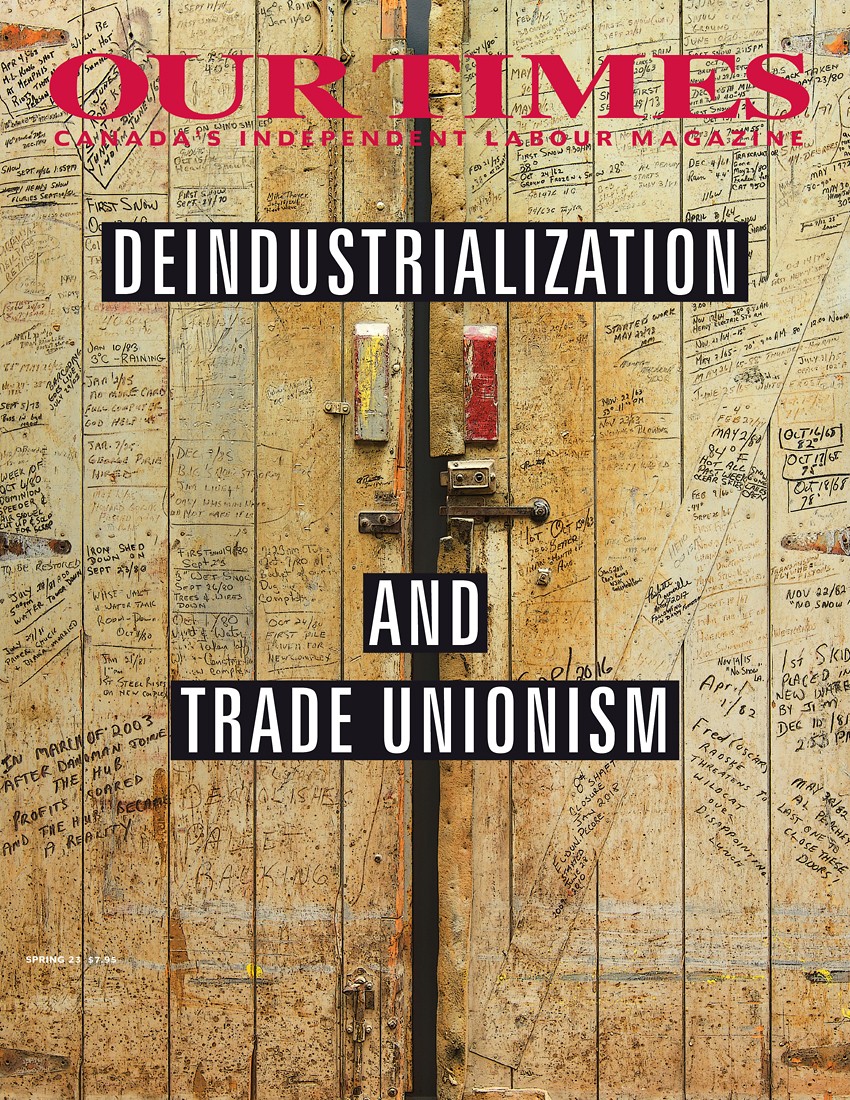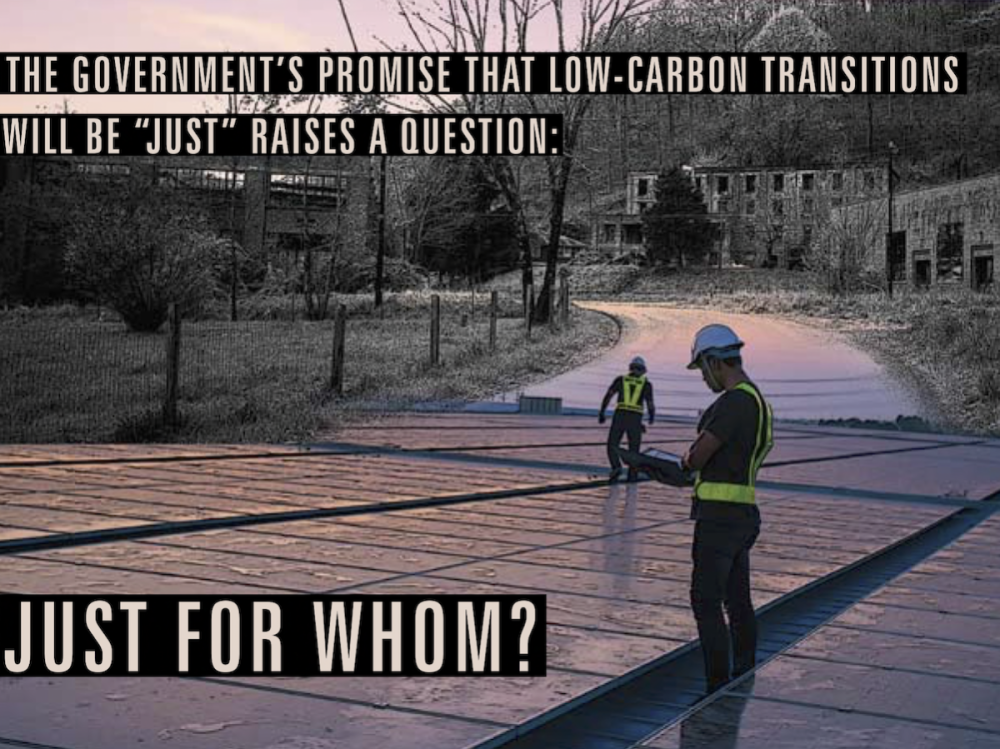In 2023, the Canadian government plans to introduce “just transition” legislation, paving the way for oil, gas, and coal workers to move into sustainable jobs. But Sonya Savage, who was Alberta's Minister of Environment and Protected Areas in 2022, met this announcement with fierce criticism, dismissing the term just transition as “divisive” and “polarizing.” Many workers and communities across the political spectrum in Canada also remain unconvinced. After all, most transitions from coal and other heavy-polluting industries have, to date, been deeply unjust. Aside from bearing the long-term effects of toxic pollution, workers and their communities have dealt with job losses, urban decline, poverty, stigmatization, and profound uncertainty about the future. The federal government’s promise that low-carbon transitions will be “just” raises an important question: just for whom?
Just transition is widely recognized as a mainstream climate-policy term which gained momentum following the Katowice Climate Change Conference (COP24), held in 2018 in Polish coal country. At COP24, heads of state adopted the Solidarity and Just Transition Silesia Declaration, aimed at gaining approval from displaced fossil-fuel workers and communities during transitions to low-carbon economies. Since then, international just transition policy debates have expanded their focus of concern to include a wider range of affected workers and communities, particularly Indigenous Peoples on the frontlines of the climate crisis.
But, contrary to popular belief, the concept of just transition did not emerge in response to the climate crisis.
In the decades after the Second World War, a vast array of newly synthesized chemicals was produced and marketed around the world, before the toxic risks were known. Factory workers were often the first to be exposed to these hazardous chemicals. They suffered occupational illnesses and untimely deaths. Labour activists and others pushed for worker protections, environmental regulations, and bans, with unionized workers demanding just transitions not only to protect their livelihoods and communities, but also to protect their lives and health.
THE U.S. EXAMPLE
In the 1970s and 1980s, the U.S. labour movement fought to bridge labour, occupational health, and environmental justice issues. Labour activists wanted protections offered to displaced workers when toxic polluting industries were closed. The call for just transition arose then, and as the North American public grew increasingly concerned over the health and environmental impacts of hazardous industries. It also coincided with the wave of deindustrialization that swept through heavy manufacturing industries in the North American Rust Belt, leaving abandoned industrial facilities and toxic pollution in its wake.
That swell of deindustrialization in North America was widely characterized by unjust transitions — a collective trauma that lingers in the minds of workers. The calls for just transitions, led by workers and strengthened by coalitions, were based on an understanding that labour, environmental, health, and social-justice issues are closely entwined. They were also based on the understanding that it was in workers’ best interests to transition away from toxic, environmentally destructive industries, and that workers expected financial compensation, retraining, and social support through the transition.

This article is from our Spring 2023 edition. This special issue tackles global deindustrialization and worker fightback for fair treatment across sectors, industries, and borders. Head to ourtimes.ca/magazine to see what’s in the latest issue.
In the United States, Tony Mazzocchi of the Oil, Chemical and Atomic Workers Union proposed a “Superfund for Workers,” which would compensate and retrain those who moved out of environmentally hazardous jobs. It’s widely believed that Mazzocchi was the first to use the term just transition, and this superfund was meant to parallel the U.S. Superfund Act of 1980 — national legislation to tax corporations to clean up hazardous waste sites across the country.
The Superfund for Workers never came to fruition. Instead, polluting chemical and petrochemical industries fought for their survival, swiftly launching public campaigns denying that their products were harmful. They fought relentlessly to delay and subvert environmental and health regulations — a practice which continues to this day. Meanwhile, alliances between labour and environmental activists gradually dissipated, both in the U.S. and internationally, as employers in polluting industries resorted to “job blackmail,” forcing workers to choose between their jobs and their health. Problems of toxic exposures within polluting industries continued, but proactive calls for just transition diminished. In international trade union debates, it was only in response to increasing concerns about climate change that the concept of just transition resurfaced.
JUST TRANSITION NOW
Amid the public’s growing concern over the climate crisis, just transition debates have diversified and extended their scope and sense of urgency. But in practice, those debates still tend to happen primarily when plants or other industrial sites are about to be shut down, or are slated for closure. Decarbonization remains the central priority in just transition policies. Concerns about injustice have been sidelined. But the climate crisis, the problem of toxic pollution, and the need for healthy livelihoods remain deeply interconnected and have important implications for just transition today.
The important question of “just for whom” in just transition cuts across multiple issues and intersections of social inequality and injustice. The discussion must include but also extend beyond the loss of livelihoods that depend on fossil fuels. We must also look at how toxic hazards are unjustly displaced across low-carbon global supply chains and how the quality, security, and safety of “green jobs” is unevenly distributed. As well, we must consider the land grabbing involved to secure “carbon sinks,” and the unequal benefits and risks people and communities experience from the growth of green technological “solutions.” Otherwise, low-carbon transitions risk reproducing the inequalities that exist within the fossil-fuel-based economy across local, national, and global lines.
Considering these issues and intersections when planning for just transition will help to avoid repeating the mistakes of the past and allow us to promote genuinely sustainable, equitable, and just societal transformations. Without a clear, locally empowering, and holistic vision of what the future will look like in communities where workers now depend on resources for their livelihoods, it is only understandable that some workers and communities across North America will meet planned just transitions with resistance.
Alice Mah teaches sociology at the University of Warwick in the United Kingdom. Mah is one of almost 30 contributors to the unique Spring 2023 issue of Our Times, which tackles global deindustrialization and worker fightback for fair treatment across sectors, across industries, and across borders. This issue was produced in cooperation with Steven High of Concordia University's Centre for Oral History and Digital Storytelling.











